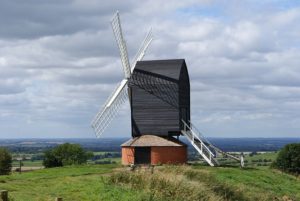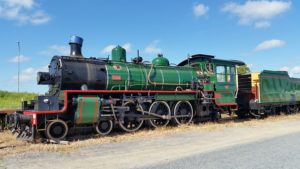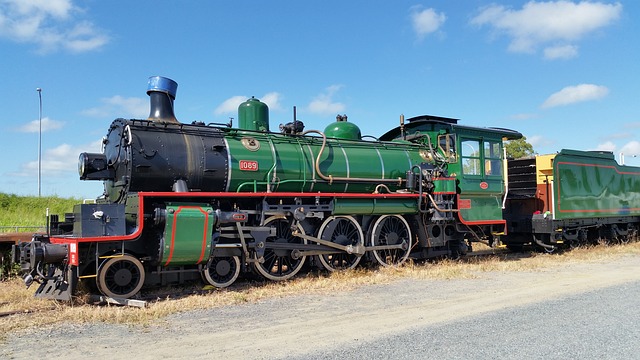Steam Powered Machinery
Steam Powered Machinery, was running as far back as 1770’s & 1780’s, but slow and dangerous. Water pumps were running on steam-powered engines in 1712! So it was not the first thing to be on the minds of new factory owners at that time, as a reliable power source. As wind & water were the main power sources, and to lesser extent animals.
But the need for more & dependable power sources was on the horizon and a few at first were adventurous enough to take on this new means of power. Within a few short years, they would come to reap the benefits of new techniques & developments being introduced.
Steam engines were now the new kid on the block. No longer would they be held back by beam action engines only. But now they were full steam-driven rotary engines, getting faster and more powerful they could rival the largest of water wheels anywhere!
The Natural Elements

This would mean that mills were at the mercy of the natural weather elements for their power source. Watermills needed a constant supply of running water, so in dry weather spells many could find themselves with a reduced or no water at all to drive the water wheels.
But not to be outdone completely, many mills would build up-stream large holding ponds or dams on the rivers to maintain their power source all year round.
Much the same faith would befall the windmill in calm weather conditions!
But here also, there was no means to secure a constant supply of wind. Only those that were built in or near coastal regions, open plains or in valleys would have a natural advantage of a more constant power supply.
But, again no guarantee for all the year-round power sources.
Technological developments were coming to hand
The time came with the help of new technology and inventions that made rotary motion possible in a new wave of steam-powered engines. The genie was out of the bottle and what was to follow became nothing less than amazing!
Steam engine developments were gathering pace and more factories were built to be powered by a single steam engine. Just as with large water wheels, where a single rotating shaft entered the building from which would be attached a pully or gear to drive the mill machinery.
This trend was now picking up speed and by the late 1790s many factories were starting up with steam power. While under the new trend of Arkwright’s factory system, production was rapidly moving from the domestic or village setting. Large factories in most cases use a single steam engine as the main power source. Which now, could be placed more central in the factory-powered system.
This also meant that large numbers of people were required to work in these new factories up and down the country. So new towns sprang up in many areas within a few years.
This shift to places that were easier to reach by transporting raw materials and goods. Now people could travel to and from work with greater ease. First were all brought about by the rise in the canal networks, and later the railways, this enabled towns and villages to spring up in new areas across the country.

However; the cost of raw materials such as cotton & wool for textiles, coal, and iron prices was falling in the early 1800s. Which was helped by the new transport system of canals that extensively crossed the countryside?
This would go on to boost the industrial expansion of Britain.
With the increase in demand for steam power engines taking place, coupled with the need to fulfil the new manufacturing processes. With the new steam-powered machinery, these would create new towns, where only villages had stood before.
The demand for all kinds of goods increased on a global scale, which was unheard of before.
The Factory Steam Engine
About 1820 water and steam power were about equal in use in many industries, but by the 1830’s the momentum of the steam engine was rapidly overtaking all other kinds of power systems in use. Many new industries sprang up many of which could not be perceived only a few years earlier. But with a small steam engine, they would now have the power source to drive many different kinds of machinery from small workshops to huge factories.
The Railway Steam Engine

With the use of a steam engine & boiler system combined and mounted on steel wheels that run on iron rails…!
The railway system was born in the early 18oo’s, first used to move coal and spoil in many mines in various parts of the country. In under 20 years, we were to see the Rainford trials.
These were set up and run to find the best steam railway engine to pull the first passenger trains on a new railway built between Liverpool and Manchester. With these two rapidly expanding cities the growth in transportation for goods and people in large numbers was needed to move them in both directions between the two cities!
This was soon to become the most in-demand transport system to be built on a worldwide scale. So in a few short years what followed, was nothing short of a second industrial revolution.
The Growth of Industries
Many industries were to spring up to fulfil the demand for new rail systems as every city in the world wished to be linked to its neighbouring cities and towns. This was to make a huge demand for all kinds of skills needed. Demand for skilled people required to try and fulfil many new and expanding industries was now springing up all over the country and empire!
The Power of Steam
As the use of steam engines grew from very small size units to large unimaginable monsters! As an example, near Wigan pier is a steam museum where the original cotton mill steam engine, in its original setting can be seen working on special dates. Covid-19 Regulations permitting at this time?
This engine is a 4-cylinder, double-acting, triple-expansion unit producing 2,500 horsepower at 68 rpm…! The flywheel alone is about 40 tons of weight…!
Steam Engines were improved and refined to meet the needs of Steam Powered Machinery in factories, ships and railway engines to remain the main power source for over the next 120 years or so.
To keep pace with the demand for new steam engines, complete engineering factories were set up in many areas of the UK. As they strived to fulfil this ever-growing need for more steam engines. With this new growth came many opportunities and great wealth was made by many people.


